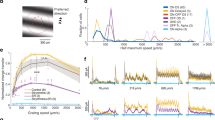Abstract
OPTOKINETIC nystagmus is the cycle of slow forward and fast return phases of the eye when it follows a continuous movement in the whole visual field. Although optokinetic nystagmus has been frequently studied in a variety of animals, there is no information as to how the point of onset of the fast return phase is determined. In the crab Carcinus both eyes respond to the movement of a striped drum, although one eye moves towards the midline while the other moves away from it. For both eyes to respond in either direction it is sufficient for one eye to see the drum1. J. Barnes, of this laboratory, has recently shown that the eye which makes the slow forward phase towards the midline “governs” the onset of the fast phase and leads by 30–50 msec (unpublished results).
Similar content being viewed by others
References
Horridge, G. A., and Sandeman, D. c., Proc. Roy. Soc., B, 161, 216 (1966).
Sandeman, D. C., Nature, 201, 302 (1964).
Horridge, G. A., J. Exp. Biol., 44, 233 (1966).
Horridge, G. A., Anim. Behav., suppl. 1, 163 (1964).
Hoyle, G., in The Physiology of the Insect Central Nervous System (edit. by Treherne, J. E., and Beament, J. W. L.), 203 (Academic Press, London, 1965).
Author information
Authors and Affiliations
Rights and permissions
About this article
Cite this article
HORRIDGE, G. Position of Onset of Fast Phase in Optokinetic Nystagmus. Nature 216, 1004–1005 (1967). https://doi.org/10.1038/2161004a0
Received:
Revised:
Published:
Issue Date:
DOI: https://doi.org/10.1038/2161004a0
- Springer Nature Limited





